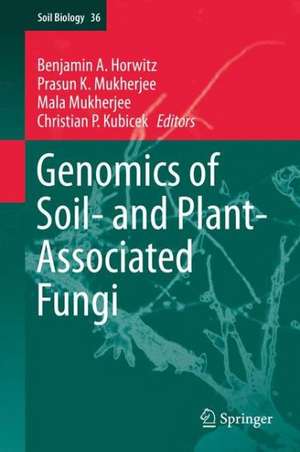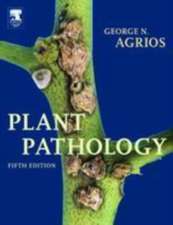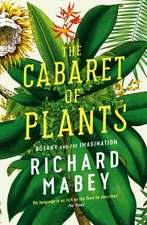Genomics of Soil- and Plant-Associated Fungi: Soil Biology, cartea 36
Editat de Benjamin A. Horwitz, Prasun K. Mukherjee, Mala Mukherjee, Christian P. Kubiceken Limba Engleză Hardback – 12 sep 2013
In addition to the model organisms Neurospora and Aspergillus, the following species are covered providing a view of pathogens and mutualists: Trichoderma, Fusarium oxysporum, Cochliobolus heterostrophus, Penicillium chrysogenum, Rhizopus oryzae, Podospora anserina, and species belonging to Agaricomycetes, Archaeorhizomycetes and Magnaporthaceae. Ecology and potential applications have guided the choice of fungal genes to be studied and it will be fascinating to follow the trends of future sequencing projects.
| Toate formatele și edițiile | Preț | Express |
|---|---|---|
| Paperback (1) | 949.55 lei 6-8 săpt. | |
| Springer Berlin, Heidelberg – 23 aug 2016 | 949.55 lei 6-8 săpt. | |
| Hardback (1) | 953.65 lei 6-8 săpt. | |
| Springer Berlin, Heidelberg – 12 sep 2013 | 953.65 lei 6-8 săpt. |
Din seria Soil Biology
- 18%
 Preț: 958.56 lei
Preț: 958.56 lei - 9%
 Preț: 1382.30 lei
Preț: 1382.30 lei - 18%
 Preț: 1225.62 lei
Preț: 1225.62 lei - 18%
 Preț: 957.75 lei
Preț: 957.75 lei - 18%
 Preț: 1232.09 lei
Preț: 1232.09 lei - 18%
 Preț: 949.90 lei
Preț: 949.90 lei - 18%
 Preț: 1392.95 lei
Preț: 1392.95 lei - 18%
 Preț: 952.26 lei
Preț: 952.26 lei - 18%
 Preț: 1231.32 lei
Preț: 1231.32 lei - 18%
 Preț: 956.03 lei
Preț: 956.03 lei - 18%
 Preț: 948.29 lei
Preț: 948.29 lei - 18%
 Preț: 1224.18 lei
Preț: 1224.18 lei - 18%
 Preț: 1226.90 lei
Preț: 1226.90 lei - 18%
 Preț: 952.26 lei
Preț: 952.26 lei - 18%
 Preț: 942.63 lei
Preț: 942.63 lei - 18%
 Preț: 946.55 lei
Preț: 946.55 lei - 18%
 Preț: 1221.20 lei
Preț: 1221.20 lei - 18%
 Preț: 1225.94 lei
Preț: 1225.94 lei - 18%
 Preț: 946.24 lei
Preț: 946.24 lei - 24%
 Preț: 1051.27 lei
Preț: 1051.27 lei - 18%
 Preț: 1221.02 lei
Preț: 1221.02 lei - 18%
 Preț: 947.98 lei
Preț: 947.98 lei - 18%
 Preț: 948.47 lei
Preț: 948.47 lei - 18%
 Preț: 1222.31 lei
Preț: 1222.31 lei - 18%
 Preț: 1231.64 lei
Preț: 1231.64 lei - 18%
 Preț: 1225.31 lei
Preț: 1225.31 lei
Preț: 953.65 lei
Preț vechi: 1162.99 lei
-18% Nou
Puncte Express: 1430
Preț estimativ în valută:
182.48€ • 191.04$ • 150.99£
182.48€ • 191.04$ • 150.99£
Carte tipărită la comandă
Livrare economică 05-19 aprilie
Preluare comenzi: 021 569.72.76
Specificații
ISBN-13: 9783642393389
ISBN-10: 3642393381
Pagini: 400
Ilustrații: XII, 388 p. 42 illus., 25 illus. in color.
Dimensiuni: 155 x 235 x 27 mm
Greutate: 0.68 kg
Ediția:2013
Editura: Springer Berlin, Heidelberg
Colecția Springer
Seria Soil Biology
Locul publicării:Berlin, Heidelberg, Germany
ISBN-10: 3642393381
Pagini: 400
Ilustrații: XII, 388 p. 42 illus., 25 illus. in color.
Dimensiuni: 155 x 235 x 27 mm
Greutate: 0.68 kg
Ediția:2013
Editura: Springer Berlin, Heidelberg
Colecția Springer
Seria Soil Biology
Locul publicării:Berlin, Heidelberg, Germany
Public țintă
ResearchCuprins
Genomic contributions to the study of soil and plant-interacting fungi.- Fungal genomics for energy and environment.- Advancement of functional genomics of a model species of Neurospora and its use for ecological genomics of soil fungi.- Major Plant Pathogens of the Magnaporthaceae Family.- Aspergillus - Genomics of a cosmopolitan fungus.- Trichoderma – genomic aspects of mycoparasitism and biomass degradation.- Fusarium oxysporum: A "moving" view of pathogenicity.- Genomics and spectroscopy provide novel insights into the mechanisms of litter decomposition and nitrogen assimilation by ectomycorrhizal fungi.- Cochliobolus heterostrophus, a Dothideomycete pathogen of maize.- Penicillum chrysogenum - the genomics of antibiotics production.- Rhizopus oryzae - genetic secrets of an emerging human pathogen.- Podospora anserina: from laboratory to biotechnology.- Recent advances on the genomics of litter- and soil-inhabiting Agaricomycetes.- Archaeorhizomycetes, patterns of distribution and abundance in soil.- Methods in Fungal Genetics.
Recenzii
From the book reviews:
“The book is an outcome of contributions by international experts. It contains 15 chapters with references and an index at the end of the book. … The book is valuable for mycologists and researchers working in the field of genomics, genetics and plant pathology. A requisite guide for students studying fungal biotechnology.” (Melvina D’souza and Kevin D. Hyde, Fungal Diversity, December, 2014)
“The book is an outcome of contributions by international experts. It contains 15 chapters with references and an index at the end of the book. … The book is valuable for mycologists and researchers working in the field of genomics, genetics and plant pathology. A requisite guide for students studying fungal biotechnology.” (Melvina D’souza and Kevin D. Hyde, Fungal Diversity, December, 2014)
Textul de pe ultima copertă
This volume addresses the similarities and also the differences in the genomes of soil saprophytes, symbionts, and plant pathogens by using examples of fungal species to illustrate particular principles. It analyzes how the specific interactions with the hosts and the influence of the environment may have shaped genome evolution. The relevance of fungal genetic research and biotechnological applications is shown for areas such as plant pathogenesis, biomass degradation, litter decomposition, nitrogen assimilation, antibiotic production, mycoparasitism, energy, ecology, and also for soil fungi turning to human pathogens.
In addition to the model organisms Neurospora and Aspergillus, the following species are covered providing a view of pathogens and mutualists: Trichoderma, Fusarium oxysporum, Cochliobolus heterostrophus, Penicillium chrysogenum, Rhizopus oryzae, Podospora anserina, and species belonging to Agaricomycetes, Archaeorhizomycetes and Magnaporthaceae. Ecology and potential applications have guided the choice of fungal genes to be studied and it will be fascinating to follow the trends of future sequencing projects.
In addition to the model organisms Neurospora and Aspergillus, the following species are covered providing a view of pathogens and mutualists: Trichoderma, Fusarium oxysporum, Cochliobolus heterostrophus, Penicillium chrysogenum, Rhizopus oryzae, Podospora anserina, and species belonging to Agaricomycetes, Archaeorhizomycetes and Magnaporthaceae. Ecology and potential applications have guided the choice of fungal genes to be studied and it will be fascinating to follow the trends of future sequencing projects.
Caracteristici
With contributions by international experts A valuable source of information for scientists in microbiology, agriculture, and biofuels industry Describes the basic genetics and the potential applications of fungi and their secondary metabolites Includes supplementary material: sn.pub/extras





